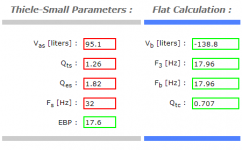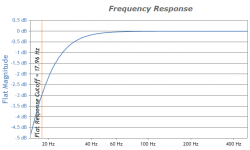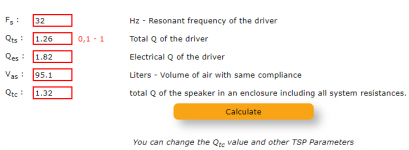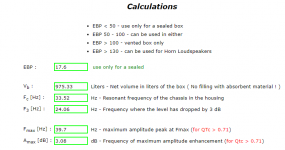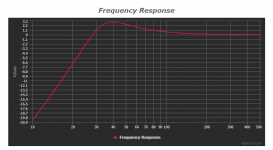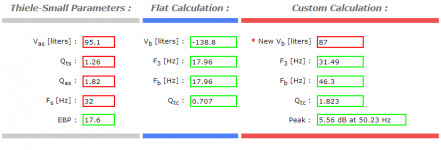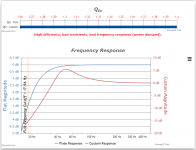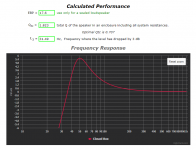I’m planning to build a pair of large floor-standing speakers which will contain a pair of 12” woofers, a 6” midrange and a 1” tweeter.
I found an interesting woofer which, in fact, may be a subwoofer. At least, the price is affordable and the appearance is right to my eyes. It’s GRS 12PR-8. GRS 12PR-8 - 12" Woofer
I went to an online calculator and put the driver’s parameters in it. Yet, I was astonished when the results obtained was suggested that these woofers need about 925 litres of sealed enclosure volume, also produce Q about >= 1, recommended Q was approx. 1.6!
Thus, I’m wondering that if these woofers are designed for infinite baffle. However, as my intention is to build sealed enclosures which will have volume approximately 85 litres (3 cu.ft.) per woofer and crossing them at about 85 Hz with 12 dB/octave slope.
I doubt that if these woofers are really designed for infinite baffle enclosure type, can I put them into a sealed enclosure? Will it have any problems? Is it a bad idea?
I found an interesting woofer which, in fact, may be a subwoofer. At least, the price is affordable and the appearance is right to my eyes. It’s GRS 12PR-8. GRS 12PR-8 - 12" Woofer
I went to an online calculator and put the driver’s parameters in it. Yet, I was astonished when the results obtained was suggested that these woofers need about 925 litres of sealed enclosure volume, also produce Q about >= 1, recommended Q was approx. 1.6!
Thus, I’m wondering that if these woofers are designed for infinite baffle. However, as my intention is to build sealed enclosures which will have volume approximately 85 litres (3 cu.ft.) per woofer and crossing them at about 85 Hz with 12 dB/octave slope.
I doubt that if these woofers are really designed for infinite baffle enclosure type, can I put them into a sealed enclosure? Will it have any problems? Is it a bad idea?
Last edited:
Those woofers aren't necessarily designed for IB so much as designed to meet a specific price point, which results in a primitive motor assembly and small magnet, which when combined with other cost saving measures can result in a driver with a very high qts. These drivers can still work in enclosures, but as enclosure volumes drop, you'll get a bump in output above fs along with a fairly steep rolloff below that. This is how a lot of the older sealed designs from the 70s and 80s were. Some call it "warm", others call it "boomy". Either way, your best bet is to experiment with alignments in Win ISD or similar modelling programs to see how it will work in whatever enclosure size you are targeting. You may find that spending slightly more for something like a Dayton Classic woofer will yield far better results. That's what I ended up doing on a very low budget 10* 3 way that I'm currently working on.
that GRS driver : high qts, low xmax, small magnet, low wattage  i don't find any good parameter as a good woofer or even subwoofer which are on opposite on those parameters to be considered as "good"
i don't find any good parameter as a good woofer or even subwoofer which are on opposite on those parameters to be considered as "good"
find other driver which you can find and afford, Dayton has good review but not sure if you can purchase it locally in your country. SBAcoustic has many good woofers but their price might be an issue for 2 drivers on each side
find other driver which you can find and afford, Dayton has good review but not sure if you can purchase it locally in your country. SBAcoustic has many good woofers but their price might be an issue for 2 drivers on each side
I agree with the previous posters, and would look for something better. However, I will throw you a lifeline! 
The Qts figure suggests the woofers are best suited to free-air or infinite baffle loading.
However, retailers are suggesting a sealed enclosure volume of 2.72 cu ft which they say gives an f3 of 34 Hz. Note that I can't verify this!
Reviews show that people are successfully replacing their worn out 12" drivers with this unit and it's a shoo-in that their enclosures will be no larger than the 3 cu ft that you desire.
This is an economical replacement/repair driver and as such may be regarded as a jack of all trades and master of none.
Note its low sensitivity of 84dB/W/m.
The Qts figure suggests the woofers are best suited to free-air or infinite baffle loading.
However, retailers are suggesting a sealed enclosure volume of 2.72 cu ft which they say gives an f3 of 34 Hz. Note that I can't verify this!
Reviews show that people are successfully replacing their worn out 12" drivers with this unit and it's a shoo-in that their enclosures will be no larger than the 3 cu ft that you desire.
This is an economical replacement/repair driver and as such may be regarded as a jack of all trades and master of none.
Note its low sensitivity of 84dB/W/m.
I modeled this quickly and it gives about a 6dB bump at around 47hz, followed by a fairly steep rolloff below that. Even with an 85hz electronic high pass, you're going to end up with a "flat" frequency response to some frequency well below 80hz, so unless you have the ability to customize the electronic high-pass filter, you're going to find it difficult to integrate with a sub unless you lower the sub's low pass to compensate.
This definitely isn't an insurmountable effort, but for the extra $20/each to upgrade to a Dayton DC-300, you're going to get a much better response around your proposed 85hz high pass.
This definitely isn't an insurmountable effort, but for the extra $20/each to upgrade to a Dayton DC-300, you're going to get a much better response around your proposed 85hz high pass.
I agree with the previous posters, and would look for something better. However, I will throw you a lifeline!
The Qts figure suggests the woofers are best suited to free-air or infinite baffle loading.
However, retailers are suggesting a sealed enclosure volume of 2.72 cu ft which they say gives an f3 of 34 Hz. Note that I can't verify this!
Reviews show that people are successfully replacing their worn out 12" drivers with this unit and it's a shoo-in that their enclosures will be no larger than the 3 cu ft that you desire.
This is an economical replacement/repair driver and as such may be regarded as a jack of all trades and master of none.
Note its low sensitivity of 84dB/W/m.
The F3 in a 2.5-3 cube enclosure is somewhere in the mid 30s, but the 6dB boost at 45hz really makes the "-3dB" point 9dB down from the peak.
...can I put them into a sealed enclosure? Will it have any problems? Is it a bad idea?
No, it is not a bad idea, it is simply a super budget driver. Your initial simulation gave you Qtc in the 1.6 range, but it was such because program did not take absorbtion losses into account, which will be introduced by stuffing the cabinet properly lowering Qtc to near 1.2-1.3. This is a very desirable side effect in your case.
I would suggest increasing the x/o point to about 200-300Hz if you are to build passive filters. I think this unit should be able to play normally that high.
I'd like to stress out that a good sounding loudspeaker based on budget drivers is not so easily accomplished and this is the answer to your question whether there will be any problems.
Last edited:
I would suggest increasing the x/o point to about 200-300Hz if you are to build passive filters. I think this unit should be able to play normally that high.
Could you help to explain why you suggest x/o point at about 200-300 Hz, please?
Initially, I confess that I intended to use a 200-300 Hz range as I saw many high-end speakers did. Yet, I also see nowadays designs i.e. Focal use a 80-100 Hz range and claim that it is an integrated subwoofer concept. Thus, I thought it might be an idea that the lower is better, but, I’m not sure.
Even with an 85hz electronic high pass, you're going to end up with a "flat" frequency response to some frequency well below 80hz, so unless you have the ability to customize the electronic high-pass filter, you're going to find it difficult to integrate with a sub unless you lower the sub's low pass to compensate.
I’m not sure why we need to archive a flat response at bass region. Actually, there’s one reason that I choose this driver is because of its bump at bass response. I have read on somewhere that the human’s ear is not react to sound linearly, but, something called a contour/ loudness curve instead. Thus, I’d love a non-linear response of this driver, but I confess that I’m not sure whether my thought is correct.
Many people love a boomy bass with a rise & fall but if you are trying to reproduce something accurately like grand piano, it is not a good simulation.
I see you are in Thailand. Prv operates in that country prvaudio.com ; try to find something from them. I see a 10" prv for sale here for $64, that is certainly a bargain and I'm not recommending it. Look at the qt, vas, fs. I just bought some 15" (381 mm) eminence Deltapro15A qt .4 vas 243 L fs 42 hz. $169 free freight. They didn't save money on the magnet: it weighs 2.26 kg.
I see you are in Thailand. Prv operates in that country prvaudio.com ; try to find something from them. I see a 10" prv for sale here for $64, that is certainly a bargain and I'm not recommending it. Look at the qt, vas, fs. I just bought some 15" (381 mm) eminence Deltapro15A qt .4 vas 243 L fs 42 hz. $169 free freight. They didn't save money on the magnet: it weighs 2.26 kg.
Last edited:
Could you help to explain why you suggest x/o point at about 200-300 Hz, please?
Because of unnecessary circuit complexity and cost as a direct result of it, not to mention lack of benefit from this design choice.
Well, the cabinet volume seems no longer be a problem. I can't wait to see these drivers in 3 cu.ft. enclosures. What do you guys think?
The next query is on crossover point. It's tough to decide which x/o point I should employ; between lower than 100 Hz and at 200-300 Hz region.
I was inspired by my favorite Braun M15 speakers which contains 2 x 10" woofers, a 5.25" midrange and a 1" tweeter. Crossover points are at 2,500 and 200 Hz! Unbelievably, I listen to them everyday!
I'd love to hear the comments from everyone on the discussion of x-over point. Is my thought correct "lower is better"? Is it a trend for nowadays speakers?
Thanks in advance
The next query is on crossover point. It's tough to decide which x/o point I should employ; between lower than 100 Hz and at 200-300 Hz region.
I was inspired by my favorite Braun M15 speakers which contains 2 x 10" woofers, a 5.25" midrange and a 1" tweeter. Crossover points are at 2,500 and 200 Hz! Unbelievably, I listen to them everyday!
I'd love to hear the comments from everyone on the discussion of x-over point. Is my thought correct "lower is better"? Is it a trend for nowadays speakers?
Thanks in advance
Ok, I have used online calculator to simulate my woofers in a closed box. The pictures are shown here.
First calculator, I entered all parametres in it and it showed incredibly result when it said that the box volume suggested would be -138.8 litres! with Q = 0.707 claimed its a flat response calculating.
First calculator, I entered all parametres in it and it showed incredibly result when it said that the box volume suggested would be -138.8 litres! with Q = 0.707 claimed its a flat response calculating.
Attachments
Second calculator, I entered the parametres again but now I selected my own Q. I chose Q = 0.707 as suggested by the first calculator. Yet, I couldn't obtain the result as it automatically changed the Q to 1.32!, I guess it's a recommended value, and couldn't be lower than this, only higher is allowed.
It surprises me again as it suggested that the recommended box volume is 975.33 litres!, remember that this is with Q = 1.32!.
It surprises me again as it suggested that the recommended box volume is 975.33 litres!, remember that this is with Q = 1.32!.
Attachments
Last edited:
Right, the lowest possible Qtc = Qts and results in an infinite box size [Vb], hence the negative calculation. Factor in some wiring losses and Qts rises a bit more to Qts' = [Qts']: [Qts] + any added series resistance [Rs]: Calculate new Qts with Series Resistor
[Rs] = 0.5 ohm minimum for wiring, so may be higher if a super small gauge is used as a series resistor plus any added resistance from an XO/whatever.
That said, if you had the budget for a fairly large cab, a well stuffed TL tuned to ~21 Hz will damp it flat across it's entire usable BW, so one tuned to [Fs] would tune it mostly flat, but still a bit big, but if you make your 3 ft^3 sealed cab a tall offset driver column 1/2 the TL's length and stuff it like the TL you'll get most of the benefits of both with the main difference being it won't have the TL's mid-band gain, which according to HR isn't that much unless it's really large like its specs dictate for optimal LF gain BW.
Re XO point; based solely on its inductance [Le], calculated impedance, its 8 ohms starts rising around 250 Hz, so a good place to start and if wanting > ~400 Hz, then add a reactance annulled zobel to flatten it out and choose what your ears tell you : https://www.diyaudio.com/forums/multi-way/54349-zobel-calcs-crazy.html#post607076
: https://www.diyaudio.com/forums/multi-way/54349-zobel-calcs-crazy.html#post607076
[Rs] = 0.5 ohm minimum for wiring, so may be higher if a super small gauge is used as a series resistor plus any added resistance from an XO/whatever.
That said, if you had the budget for a fairly large cab, a well stuffed TL tuned to ~21 Hz will damp it flat across it's entire usable BW, so one tuned to [Fs] would tune it mostly flat, but still a bit big, but if you make your 3 ft^3 sealed cab a tall offset driver column 1/2 the TL's length and stuff it like the TL you'll get most of the benefits of both with the main difference being it won't have the TL's mid-band gain, which according to HR isn't that much unless it's really large like its specs dictate for optimal LF gain BW.
Re XO point; based solely on its inductance [Le], calculated impedance, its 8 ohms starts rising around 250 Hz, so a good place to start and if wanting > ~400 Hz, then add a reactance annulled zobel to flatten it out and choose what your ears tell you
I wouldn’t waste time, wood or money to assemble anything with that driver. It looks like garbage. If you have an old cabinet laying around then sure why not but doing wood work investing in crossover etc make absolutely no sense. If you’re serious about building a 3-way from scratch I’d look at drivers allowing more flexibility (sensitivity, power, response). I might be wrong but this isn’t worth it. Cutting at 85hz seems also crazy. Unless you plan to do an active sub design with the 6,5” as satellite, but then the 84dB/100watt “sub” won’t keep up.
Start over, a 3-way 12” design is complex and pricey from a cabinet and crossover perspective, and to go down that route with cheap drivers won’t turn out very well
What’s your budget?
Room size?
Music preference?
Amplifier strategy?
Start over, a 3-way 12” design is complex and pricey from a cabinet and crossover perspective, and to go down that route with cheap drivers won’t turn out very well
What’s your budget?
Room size?
Music preference?
Amplifier strategy?
- Status
- Not open for further replies.
- Home
- Loudspeakers
- Multi-Way
- Infinite baffle woofers in an enclosure
